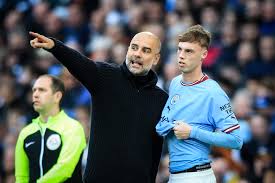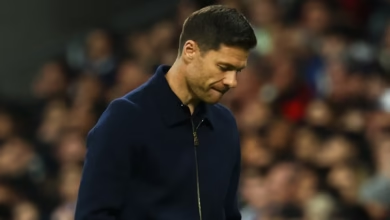Will McAtee be the latest academy star to depart Man City?

Manchester City’s Etihad Campus stands as one of the most impressive youth development facilities in world football, a testament to the club’s ambition to nurture the next generation of talent. Yet, paradoxically, the very success of this academy has created a recurring narrative that threatens to undermine its long-term objectives. James McAtee, the 22-year-old midfielder who has emerged as one of the brightest prospects from City’s youth system, now finds himself at the center of this familiar story – a tale of promise, potential, and the increasingly difficult path from academy graduate to first-team regular at one of Europe’s elite clubs.
The question surrounding McAtee’s future at Manchester City is not merely about one player’s career trajectory; it represents a microcosm of the broader challenges facing modern football’s most successful clubs. How do you balance the need for immediate success with the long-term development of young talent? How do you justify keeping promising players when world-class alternatives are readily available in the transfer market? And perhaps most importantly, how do you prevent your academy from becoming nothing more than a profitable production line for rival clubs?
The Exodus: A Pattern Emerges
To understand McAtee’s situation, one must first examine the broader context of Manchester City’s recent academy departures. The list of talented youngsters who have left the club in recent years reads like a who’s who of English football’s brightest prospects. Cole Palmer’s £40 million move to Chelsea in 2023 serves as the most prominent example of this trend, but he is far from alone in seeking opportunities elsewhere.
Liam Delap, the striker whose physical presence and clinical finishing ability marked him as a potential future star, departed for Ipswich Town in a deal that could rise to £20 million. Romeo Lavia, the Belgian midfielder whose composure and technical ability belied his years, moved to Southampton before eventually joining Chelsea for a combined fee that exceeded £50 million. James Trafford, the goalkeeper who represented England at youth level, found his path to first-team football at Burnley after struggling to break into City’s senior setup.
Each of these departures tells a similar story: talented players who excelled in City’s youth system but found their pathway to regular first-team football blocked by the club’s star-studded senior squad. The pattern is so consistent that it has become almost predictable – identify the most promising academy graduates, watch them excel at youth level, see them struggle for opportunities in the first team, and eventually witness their departure to clubs where they can secure regular playing time.
McAtee’s Journey: From Promise to Crossroads
James McAtee’s development trajectory mirrors that of many of his predecessors, yet his story contains unique elements that make his potential departure particularly significant. Unlike some academy graduates who struggle to adapt to senior football, McAtee has already demonstrated his ability to compete at the highest level. His 15 Premier League appearances for Manchester City last season, while limited, showed glimpses of the technical ability and tactical awareness that have made him such a coveted prospect.
The midfielder’s decision to forgo Manchester City’s Club World Cup campaign in favor of captaining England’s Under-21 team to European Championship glory in Slovakia proved to be a masterstroke in terms of raising his profile. Leading his country to continental success at youth level demonstrated not only his individual quality but also his leadership capabilities – attributes that are highly valued in the modern game.
McAtee’s loan spell at Sheffield United during the 2023-24 season provided him with invaluable experience of Premier League football, albeit in a struggling team that was eventually relegated. This exposure to top-flight football, combined with his continued development in City’s setup, has created a player who possesses more senior experience than many of his academy contemporaries had when they made their moves away from the club.
The comparison to Cole Palmer is particularly apt, as both players found themselves in similar situations – talented academy graduates with limited first-team opportunities at City, facing the choice between patience and immediate regular football elsewhere. Palmer’s subsequent success at Chelsea, where he has become one of the Premier League’s most exciting attacking talents, serves as both inspiration and warning for McAtee’s decision-making process.
The Valuation Dilemma: Setting the Price
Manchester City’s reported asking price of £25 million for McAtee reflects the club’s awareness of his potential value, though sources suggest the club would seek significantly more than this figure. This valuation places McAtee in an interesting position within the current transfer market. It’s substantial enough to represent a significant investment for potential suitors, yet not so prohibitive as to deter serious interest from clubs capable of offering him regular first-team football.
The pricing strategy also reflects City’s broader approach to academy sales in recent years. The club has shown itself willing to sell promising youngsters, but only at valuations that reflect their potential rather than their current status. This approach serves multiple purposes: it maximizes the financial return on the club’s academy investment, it ensures that only genuinely committed clubs pursue their targets, and it provides a degree of protection against criticism that the club is simply selling talent cheaply.
However, this pricing strategy also creates its own challenges. Setting high valuations for players with limited first-team experience can limit the pool of potential buyers, potentially leaving talented individuals in limbo between being too expensive for clubs that could offer them regular football and too inexperienced for clubs willing to pay premium prices.
The Suitors: Premier League and Bundesliga Interest
The reported interest from clubs in both the Premier League and Bundesliga highlights the breadth of McAtee’s appeal and the international recognition of his talent. Premier League interest is particularly significant, as it suggests that rival English clubs view him as capable of making an immediate impact in the top flight. This domestic interest also raises the possibility of McAtee facing his former club in direct competition, adding an extra layer of complexity to any potential transfer.
Bundesliga interest is equally intriguing, as German clubs have historically provided excellent platforms for young English talent to develop. The German league’s reputation for tactical sophistication and youth development could provide McAtee with the ideal environment to reach his full potential. Clubs like Borussia Dortmund, RB Leipzig, and Bayer Leverkusen have all demonstrated their ability to nurture young talent while competing at the highest level.
The diversity of interested parties also suggests that McAtee’s representatives have options in terms of the type of club and league where he might continue his development. Whether he prioritizes staying in England, experiencing a new footballing culture, or joining a club with specific tactical requirements, the reported interest suggests he will have meaningful choices to make.
The Academy Production Line: Success or Failure?
Manchester City’s academy success in producing talented players who subsequently excel elsewhere raises fundamental questions about the purpose and success metrics of youth development in modern football. From a purely financial perspective, the academy has been remarkably successful. The combined transfer fees received for recent academy graduates run into hundreds of millions of pounds, representing an excellent return on investment.
However, the football purist might argue that the true measure of an academy’s success should be the number of graduates who establish themselves in the first team of their parent club. By this metric, City’s academy presents a more mixed picture. While players like Phil Foden have successfully made the transition from academy to first-team regular, the number of graduates who have achieved this feat remains relatively small compared to the overall talent produced.
This situation reflects the broader challenges facing elite clubs in the modern era. The pressure to win trophies and compete at the highest level means that first-team opportunities are often limited to established stars or exceptional talents. For most academy graduates, the mathematics of squad places and competition for positions make first-team breakthrough incredibly difficult.
The Pathway Problem: Opportunity vs. Ambition
The fundamental challenge facing McAtee, and indeed all academy graduates at elite clubs, is the tension between opportunity and ambition. Manchester City’s squad depth and quality mean that even talented youngsters may struggle to secure regular first-team football. The club’s success in recent years has been built on having world-class players in virtually every position, leaving limited space for developing talents.
This creates a difficult choice for young players: remain at the club that developed them, accept limited playing time, and hope for breakthrough opportunities, or move to a club where they can secure regular football but potentially sacrifice the chance to win major trophies and compete at the highest level. It’s a choice that has no definitively correct answer, as much depends on individual circumstances, career goals, and personal preferences.
For McAtee, the pathway to regular first-team football at City appears challenging. The club’s midfield options include established international stars and proven performers, making it difficult for even the most talented young players to break through. His age also adds urgency to his situation – at 22, he is approaching the stage where regular first-team football becomes crucial for his continued development.
The Cole Palmer Template: A Success Story
Cole Palmer’s remarkable success at Chelsea provides a compelling template for McAtee’s potential career path. Palmer’s decision to leave City for guaranteed first-team football has been vindicated by his performances at Stamford Bridge, where he has become one of the Premier League’s most exciting attacking talents. His development since leaving City demonstrates that talented players can continue to improve and reach their potential even after leaving elite clubs.
Palmer’s success also highlights the importance of finding the right club and circumstances for continued development. Chelsea’s willingness to trust young talent and provide opportunities for growth created the perfect environment for Palmer to flourish. His performances have not only justified his own move but have also increased the transfer values of other City academy graduates by demonstrating their potential quality.
The financial aspect of Palmer’s success is equally significant. His current market value far exceeds the £40 million Chelsea paid for him, representing both excellent business for the buying club and validation of City’s academy development processes. This success story provides a template that other academy graduates, including McAtee, can follow.
The International Dimension: England Success
McAtee’s success with England’s Under-21 team adds another layer to his profile and potential transfer value. International recognition, particularly as captain of a successful team, demonstrates leadership qualities and the ability to perform under pressure. His decision to prioritize international duty over club commitments also shows maturity and long-term thinking about his career development.
The European Championship victory with England’s Under-21s provides McAtee with a significant achievement that enhances his reputation and market value. International success at youth level often serves as a predictor of future senior international recognition, adding to his appeal for potential suitors. The experience of leading a team to continental success also provides valuable leadership experience that could prove crucial in his future career.
The Financial Implications: Investment vs. Return
From Manchester City’s perspective, the potential sale of McAtee represents both an opportunity and a challenge. The financial return from academy sales has become an important revenue stream for the club, helping to offset the costs of their extensive youth development programs. However, selling talented youngsters also carries the risk of disposing of players who might have contributed significantly to the first team’s success.
The club’s financial position means that academy sales are not driven by necessity but rather by strategic considerations about squad management and player development. This provides City with the luxury of being able to set high valuations and wait for the right offers, rather than being forced to sell talented players at below-market prices.
For potential buying clubs, the investment in McAtee represents a calculated risk. His talent is evident, and his track record at youth level is impressive, but the transition from academy prospect to established first-team player is never guaranteed. The fee being discussed represents a significant investment that would require careful consideration of the player’s potential and the club’s development plans.
The Tactical Considerations: Fitting the System
McAtee’s playing style and tactical attributes make him an attractive proposition for clubs playing various systems. His technical ability, vision, and versatility allow him to operate in multiple midfield roles, providing tactical flexibility for potential suitors. His experience in different tactical systems during his loan spell and with England’s youth teams demonstrates his adaptability and football intelligence.
The midfielder’s ability to contribute both defensively and offensively makes him particularly valuable in the modern game, where tactical versatility is highly prized. His physical attributes, combined with his technical skills, suggest he could adapt to various tactical demands and playing styles, making him an attractive prospect for clubs with different philosophical approaches to the game.
The Timing Factor: Market Dynamics
The timing of McAtee’s potential departure coincides with a particularly active transfer market, where clubs are willing to invest heavily in young talent. The success of similar players who have made moves to secure regular first-team football has created a precedent that makes such transfers more palatable for all parties involved.
The current market conditions also favor players seeking moves, as clubs are increasingly willing to pay premium prices for young talent with proven potential. The inflation in transfer fees for young players reflects both the scarcity of top-quality prospects and the recognition that early investment in such talent often provides excellent long-term returns.
The Personal Dimension: Career Aspirations
Ultimately, McAtee’s decision will be influenced by his personal career aspirations and priorities. If his primary goal is to win major trophies and compete at the highest level, remaining at City might be the preferred option, even if it means accepting a squad role for the foreseeable future. However, if his priority is regular first-team football and accelerated development, a move away from City might be the better choice.
The player’s age and stage of development also factor into this decision. At 22, McAtee is at a crucial juncture in his career where regular playing time becomes increasingly important for his continued progression. The next few years will be vital in determining whether he fulfills his potential and establishes himself as a top-level player.
Conclusion: The Inevitable Cycle
James McAtee’s situation represents the continuation of a pattern that has become all too familiar at Manchester City. The club’s academy continues to produce talented players who excel at youth level but struggle to break into a first team packed with world-class talent. This creates a natural cycle where promising youngsters eventually seek opportunities elsewhere, often to the benefit of rival clubs.
Whether McAtee will become the latest academy star to depart the Etihad Stadium remains to be seen, but all indicators suggest that his future lies away from Manchester City. The combination of limited first-team opportunities, significant transfer interest, and his own career development needs creates a compelling case for a move that could benefit all parties involved.
The broader implications of this situation extend beyond McAtee’s individual career prospects. It raises questions about the sustainability of the current model at elite clubs, where academy development often serves as a profitable enterprise rather than a genuine pathway to first-team football. For young players like McAtee, the challenge is navigating this complex landscape while making decisions that will shape their professional futures.
As the transfer window progresses, McAtee’s situation will continue to evolve, but his story serves as a reminder of the challenges facing young talent in modern football. The path from academy prospect to established professional is rarely straightforward, particularly at clubs where success is measured in trophies rather than development opportunities. For McAtee, the choice between security and opportunity will ultimately define the next chapter of his promising career.














